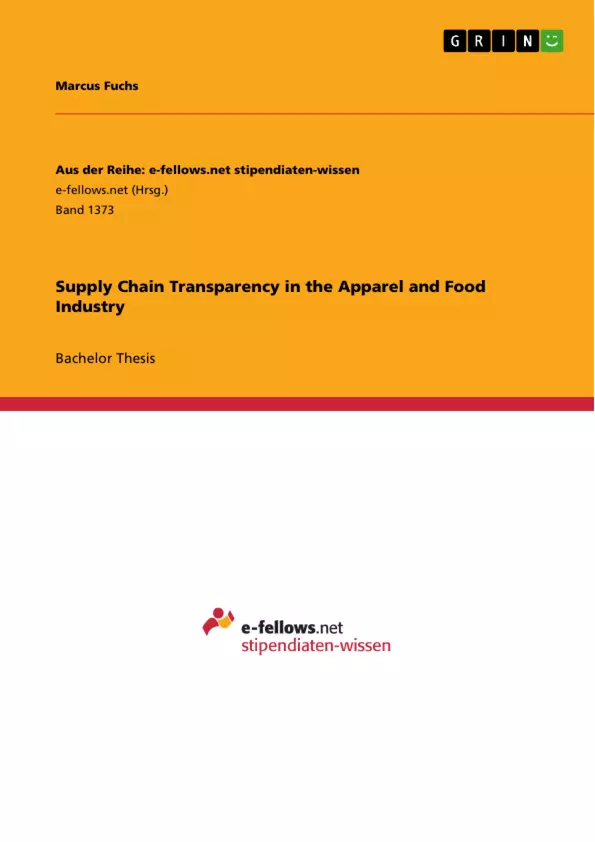Modern consumers are concerned about more than quality and price of the products they purchase. They demand concrete and credible information about the entire procurement process. Unsubstantiated company statements on the sustainability and safety of sourcing processes have proven to be insufficient to meet those demands (Hofstede, 2003). More and more companies increase the transparency of their supply chain (SC). However, in order to reach customers and to fulfill their needs, companies have to effectively communicate supply chain transparency (SCT) to the end consumer (New, 2010).
This thesis focuses on transparency in the apparel and food industry because especially here consumers claim insights into the global supply networks (Meise, 2011, p. 138). It analyzes tools to enable SCT and provides an overview of practical methods that are available to the apparel and food industry for communicating transparency to consumers. Moreover, the paper evaluates these methods based on their effectiveness at meeting consumer demand and illustrates how different approaches for enabling and communicating SCT can be combined. The presented information was obtained through extensive literature research and website analyses. An exhaustive review of the particular laws and regulations relating to transparency is out of the scope of this thesis.
First, this paper defines the concept of SCT and analyzes current consumer demand in the apparel and food industry. It explains how certain industry characteristics and recent SC scandals drive this demand. The following chapter deals with tools and methods employable by producers to gain the necessary information for fulfilling consumer demand. On the one hand, tracking and tracing within a supply network is analyzed. On the other hand, two methods for analyzing SC sustainability are addressed. In a next step, this thesis evaluates different approaches to how apparel and food companies can communicate the demanded information to consumers and, thereby, make SCs more transparent. In doing so, the concept of labeling in the apparel and food industry is analyzed. Subsequently, the use of company websites and social media for supplying customers with SC information is addressed as well. Before drawing a conclusion, the paper proposes a framework that shows how methods for obtaining SC information can be integrated with different communication channels to meet consumer demand for SCT.
Inhaltsverzeichnis (Table of Contents)
- Introduction
- Consumer demand for transparency
- Definition of supply chain transparency
- Relevant industry characteristics and developments
- Scandals driving the need for information
- Practices to enable transparency
- Tracking and tracing
- Methods for analyzing supply chain sustainability
- Life-cycle assessment
- Higg index
- Approaches to communicate supply chain information to consumers
- Product labeling
- Current approaches
- Consumer dissatisfaction
- Evaluation criteria of green labels
- Developments in the eco labeling landscape
- Company dependent communication channels
- Websites
- Social media
- Integrated solution for communicating transparency
- Product labeling
- Conclusion
Zielsetzung und Themenschwerpunkte (Objectives and Key Themes)
This thesis aims to analyze the concept of supply chain transparency (SCT) in the apparel and food industry, focusing on how companies can effectively communicate SCT to consumers. It investigates the tools and methods available for enabling SCT and evaluates different approaches for communicating this information to meet consumer demand.- Consumer demand for transparency in the apparel and food industry
- Tools and methods for enabling supply chain transparency
- Approaches for communicating supply chain information to consumers
- Evaluation of the effectiveness of different communication methods
- Integration of methods for obtaining and communicating supply chain information
Zusammenfassung der Kapitel (Chapter Summaries)
- Introduction: This chapter sets the stage by introducing the concept of supply chain transparency (SCT) and its growing importance in meeting modern consumer demands for information about product sourcing and production processes. It highlights the focus on the apparel and food industry due to the high demand for transparency in these sectors.
- Consumer demand for transparency: This chapter defines SCT from a marketing and consumer perspective, emphasizing the need for companies to understand and respond to consumer requests for information. It explores the industry characteristics and recent scandals that have driven this demand for transparency.
- Practices to enable transparency: This chapter examines tools and methods employed by producers to gather information and increase transparency within their supply chains. It analyzes tracking and tracing systems and discusses two methods for assessing supply chain sustainability: life-cycle assessment and the Higg Index.
- Approaches to communicate supply chain information to consumers: This chapter focuses on how companies can communicate SCT information to consumers. It analyzes the use of product labeling, company websites, and social media as communication channels. The chapter also examines the effectiveness of these methods in meeting consumer demand.
Schlüsselwörter (Keywords)
The main focus of this thesis lies on supply chain transparency (SCT), particularly within the apparel and food industry. Key concepts explored include consumer demand for transparency, tools and methods for enabling SCT, and approaches for communicating SCT to consumers. The thesis emphasizes the importance of understanding consumer needs and effectively communicating relevant information about product sourcing and production processes.- Quote paper
- Marcus Fuchs (Author), 2014, Supply Chain Transparency in the Apparel and Food Industry, Munich, GRIN Verlag, https://www.grin.com/document/299990



